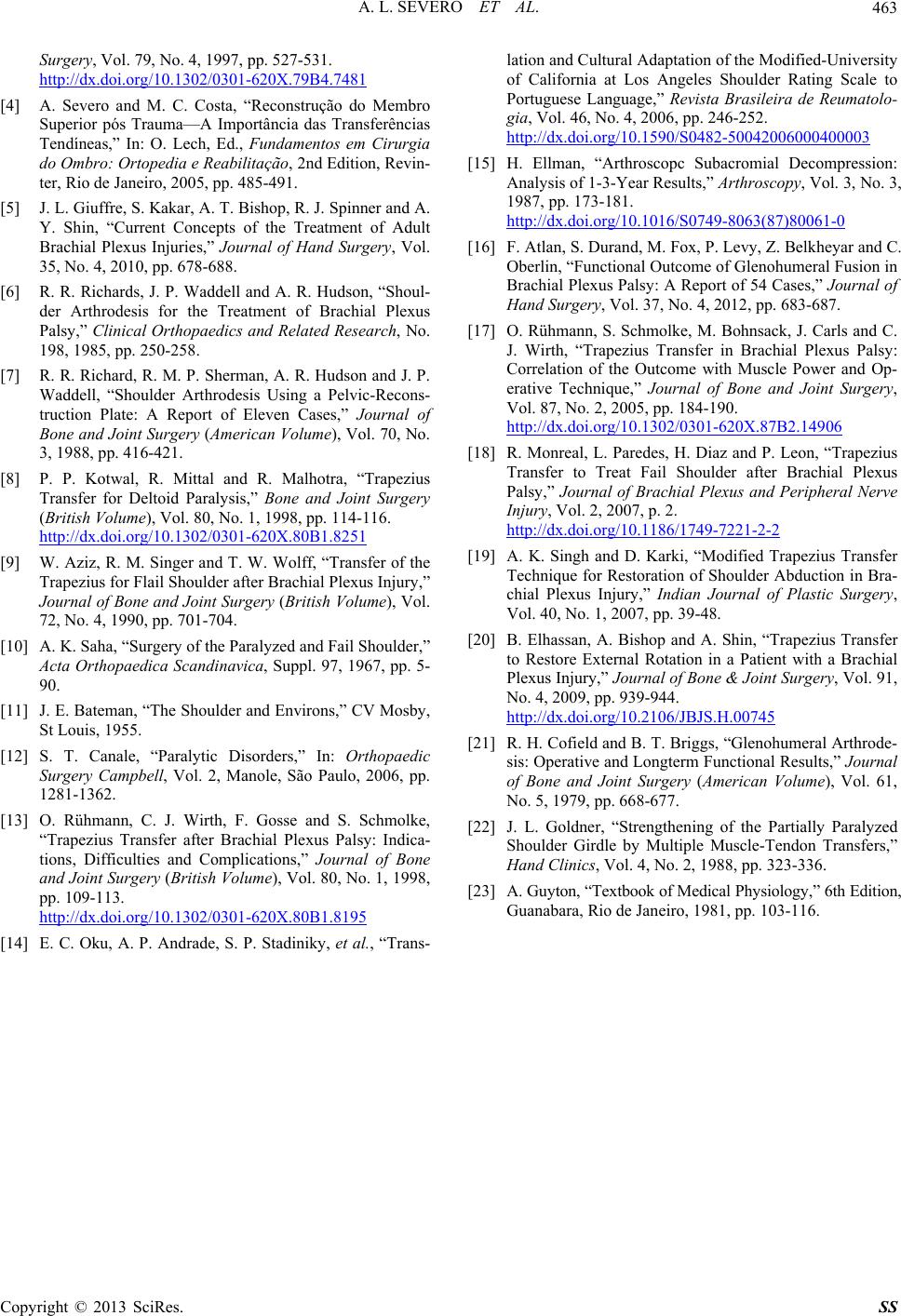
A. L. SEVERO ET AL. 463
Surgery, Vol. 79, No. 4, 1997, pp. 527-531.
http://dx.doi.org/10.1302/0301-620X.79B4.7481
[4] A. Severo and M. C. Costa, “Reconstrução do Membro
Superior pós Trauma—A Importância das Transferências
eatment of Adult
rodesis Using a Pelvic-Recons-
aralysis,” Bone and Joint Surgery
Tendíneas,” In: O. Lech, Ed., Fundamentos em Cirurgia
do Ombro: Ortopedia e Reabilitação, 2nd Edition, Revin-
ter, Rio de Janeiro, 2005, pp. 485-491.
[5] J. L. Giuffre, S. Kakar, A. T. Bishop, R. J. Spinner and A.
Y. Shin, “Current Concepts of the Tr
Brachial Plexus Injuries,” Journal of Hand Surgery, Vol.
35, No. 4, 2010, pp. 678-688.
[6] R. R. Richards, J. P. Waddell and A. R. Hudson, “Shoul-
der Arthrodesis for the Treatment of Brachial Plexus
Palsy,” Clinical Orthopaedics and Related Research, No.
198, 1985, pp. 250-258.
[7] R. R. Richard, R. M. P. Sherman, A. R. Hudson and J. P.
Waddell, “Shoulder Arth
truction Plate: A Report of Eleven Cases,” Journal of
Bone and Joint Surgery (American Volume), Vol. 70, No.
3, 1988, pp. 416-421.
[8] P. P. Kotwal, R. Mittal and R. Malhotra, “Trapezius
Transfer for Deltoid P
(British Volume), Vol. 80, No. 1, 1998, pp. 114-116.
http://dx.doi.org/10.1302/0301-620X.80B1.8251
[9] W. Aziz, R. M. Singer and T. W. Wolff, “Transfe r of
Trapezius for Flail Shoulder after Brachial Plexusthe
Injur
ca, Suppl. 97, 1967, pp. 5
uis, 1955.
ll, Vol. 2, Manole, São Paulo, 2006, pp
sfer after Brachial Plexus Palsy: Indica-
y,”
Journal of Bone and Joint Surgery (British Volume), Vol.
72, No. 4, 1990, pp. 701-704.
[10] A. K. Saha, “Surgery of the Paralyzed and Fail Shoulder,”
Acta Orthopaedica Scandinavi-
90.
[11] J. E. Bateman, “The Shoulder and Environs,” CV Mosby,
St Lo
[12] S. T. Canale, “Paralytic Disorders,” In: Orthopaedic
Surgery Campbe.
1281-1362.
[13] O. Rühmann, C. J. Wirth, F. Gosse and S. Schmolke,
“Trapezius Tran
tions, Difficulties and Complications,” Journal of Bone
and Joint Surgery (British Volume), Vol. 80, No. 1, 1998,
pp. 109-113.
http://dx.doi.org/10.1302/0301-620X.80B1.8195
[14] E. C. Oku, A. P. Andrade , S. P. Stadiniky, et al., “Trans-
6000400003
lation and Cultural Adaptation of the Modified-University
of California at Los Angeles Shoulder Rating Scale to
Portuguese Language,” Revista Brasileira de Reumatolo-
gia, Vol. 46, No. 4, 2006, pp. 246-252.
http://dx.doi.org/10.1590/S0482-5004200
n:
016/S0749-8063(87)80061-0
[15] H. Ellman, “Arthroscopc Subacromial Decompressio
Analysis of 1-3-Year Results,” Arthroscopy, Vol. 3, No. 3,
1987, pp. 173-181.
http://dx.doi.org/10.1
and C.
and C.
.87B2.14906
[16] F. Atlan, S. Durand, M. Fox, P. Levy, Z. Belkheyar
Oberlin, “Functional Outcome of Glenohumeral Fusion in
Brachial Plexus Palsy: A Report of 54 Cases,” Journal of
Hand Surgery, Vol. 37, No. 4, 2012, pp. 683-687.
[17] O. Rühmann, S. Schmolke, M. Bohnsack, J. Carls
J. Wirth, “Trapezius Transfer in Brachial Plexus Palsy:
Correlation of the Outcome with Muscle Power and Op-
erative Technique,” Journal of Bone and Joint Surgery,
Vol. 87, No. 2, 2005, pp. 184-190.
http://dx.doi.org/10.1302/0301-620X
pezius
49-7221-2-2
[18] R. Monreal, L. Paredes, H. Diaz and P. Leon, “Tra
Transfer to Treat Fail Shoulder after Brachial Plexus
Palsy,” Journal of Brachial Plexus and Peripheral Nerve
Injury, Vol. 2, 2007, p. 2.
http://dx.doi.org/10.1186/17
pezius Transfer
hin, “Trapezius Transfer
JS.H.00745
[19] A. K. Singh and D. Karki, “Modified Tra
Technique for Restoration of Shoulder Abduction in Bra-
chial Plexus Injury,” Indian Journal of Plastic Surgery,
Vol. 40, No. 1, 2007, pp. 39-48.
[20] B. Elhassan, A. Bishop and A. S
to Restore External Rotation in a Patient with a Brachial
Plexus Injury,” Journal of Bone & Joint Surgery, Vol. 91,
No. 4, 2009, pp. 939-944.
http://dx.doi.org/10.2106/JB
meral Arthrode-
ing of the Partially Paralyzed
h Edition,
[21] R. H. Cofield and B. T. Briggs, “Glenohu
sis: Operative and Longterm Functional Results,” Journal
of Bone and Joint Surgery (American Volume), Vol. 61,
No. 5, 1979, pp. 668-677.
[22] J. L. Goldner, “Strengthen
Shoulder Girdle by Multiple Muscle-Tendon Transfers,”
Hand Clinics, Vol. 4, No. 2, 1988, pp. 323-336.
[23] A. Guyton, “Textbook of Medical Phy siology,” 6t
Guanabara, Rio de Janeiro, 1981, pp. 103-116.
Copyright © 2013 SciRes. SS